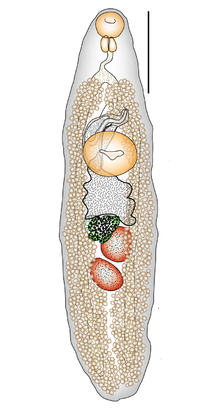
Digenea is a class of trematodes in the Platyhelminthes phylum, consisting of parasitic flatworms with a syncytial tegument and, usually, two suckers, one ventral and one oral. Adults commonly live within the digestive tract, but occur throughout the organ systems of all classes of vertebrates. Once thought to be related to the Monogenea, it is now recognised that they are closest to the Aspidogastrea and that the Monogenea are more closely allied with the Cestoda. Around 6,000 species have been described to date.

The brownspotted grouper, also known as the brown spotted reef cod, brown-spotted rockcod, coral grouper or honeycomb cod, is a species of marine ray-finned fish, a grouper from the subfamily Epinephelinae which is part of the family Serranidae, which also includes the anthias and sea basses. It has an Indo-Pacific distribution but in the northern Indian Ocean this distribution is discontinuous. It forms part of a species complex with two closely related species in the genus Epinephelus.

Lethrinus miniatus, the trumpet emperor, redthroat emperor, sweetlip emperor, Sweetlip Swoose, island snapper, yellowmouth perch, yellowmouth snapper, lipper or nannygal, is a species of marine ray-finned fish belonging to the family Lethrinidae, the emperors and emperor breams. This species is found the eastern Indo-West Pacific region.

Zoogonidae are a family of trematodes in the order Plagiorchiida.

Like humans and other animals, fish suffer from diseases and parasites. Fish defences against disease are specific and non-specific. Non-specific defences include skin and scales, as well as the mucus layer secreted by the epidermis that traps microorganisms and inhibits their growth. If pathogens breach these defences, fish can develop inflammatory responses that increase the flow of blood to infected areas and deliver white blood cells that attempt to destroy the pathogens.

The barred mudskipper or silverlined mudskipper, is a species of mudskippers native to marine, fresh and brackish waters from the African coast of the Indian Ocean, to the Marianas and Samoa in the western Pacific Ocean, and from the Ryukyus south to Australia. This species occurs in mangrove forests and nipa palm stands and can cross surfaces of mud while out of the water. This species can reach a length of 19 centimetres (7.5 in) TL. It can also be found in the aquarium trade.
Parasites of the barred mudskipper include Acanthocephalan larvae and the small Opecoelid Digenean parasite in the intestine and described from fish collected in New Caledonia.

The yellowfin goatfish is a species of goatfish native to the Indian Ocean and the Pacific Ocean.

Opecoelidae is a family of trematodes. It is the largest digenean family with over 90 genera and nearly 900 species, almost solely found in marine and freshwater teleost fishes. It was considered by Bray et al. to belong in the superfamily Opecoeloidea Ozaki, 1925 or the Brachycladioidea Odhner, 1905.

The painted sweetlips, also known as the Australian slatey, blackall, bluey, grey sweetlips, moke, morwong, mother-in-law fish, painted blubber-lips, slate bream, slate sweetlips, smokey bream, thicklip or yellowdot sweetlips is a species of marine ray-finned fish, a sweetlips belonging to the family Haemulidae. It is widespread throughout the tropical waters of the Indo-West Pacific region.

Epinephelus ongus, the white-streaked grouper, specklefin grouper, lace-finned rock-cod, specklefin rockcod, wavy-lined tock-cod, white-speckled grouper or white-spotted rock-cod, is a species of marine ray-finned fish, a grouper from the subfamily Epinephelinae which is part of the family Serranidae, which also includes the anthias and sea basses. It has a wide Indo-Pacific distribution and it is found in brackish waters as well as marine reefs.

Lethrinus atkinsoni, the Pacific yellowtail emperor,, Atkinson's emperor, reticulated emperor, tricky snapper, Tuamotu emperor, yellow morwong or yellow-tailed emperor is a species of marine ray-finned fish benomging to the family Lethrinidae, the emperor breams and emperors. This fish is found in the Western Pacific Ocean.

Lethrinus lentjan, the pink ear emperor, redspot emperor, purple ear emperor or purple-headed emperor, is a species of marine ray-finned fish belonging to the family Lethrinidae, the emperors and emperor breams. This fish is found in the Indo-Pacific region.

Lethrinus nebulosus, the spangled emperor, green snapper, morwong, north-west snapper, sand bream, sand snapper, sixteen-pounder, sharie, sheri and yellow sweetlip, is a species of marine ray-finned fish belonging to the family Lethrinidae, the emperors and emperor breams. This species is found the Indo-West Pacific region.

Lethrinus rubrioperculatus,the spotcheek emperor, red-eared emperor, red-ears, red-edged emperor, scarlet-cheek emperor, and spot cheek emperor, is a species of marine ray-finned fish belonging to the family Lethrinidae, the emperors or emperor breams. This species has a wide Indo-Pacific distribution.
Calydiscoides is a genus of monopisthocotylean monogeneans, included in the family Diplectanidae.

Hamacreadium is a genus of trematodes in the family Opecoelidae. It is synonymous with Olivacreadium Bilqees, 1976. Species of Hamacreadium are endoparasitic in fish such as Lethrinus Cuvier, 1829.
Dactylostomum is a genus of trematodes in the family Opecoelidae. It is synonyised with Opedunculata Dwivedi, 1975.
Neolebouria is a genus of trematodes in the family Opecoelidae.
Opegaster is a genus of trematodes in the family Opecoelidae.

Jean-Lou Justine, French parasitologist and zoologist, is a professor at the National Museum of Natural History in Paris, France, and a specialist of fish parasites and invasive land planarians.
















